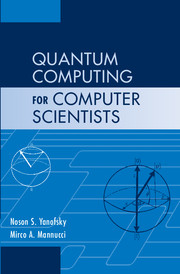Book contents
- Frontmatter
- Contents
- Preface
- Introduction
- 1 Complex Numbers
- 2 Complex Vector Spaces
- 3 The Leap from Classical to Quantum
- 4 Basic Quantum Theory
- 5 Architecture
- 6 Algorithms
- 7 Programming Languages
- 8 Theoretical Computer Science
- 9 Cryptography
- 10 Information Theory
- 11 Hardware
- Appendix A Historical Bibliography of Quantum Computing
- Appendix B Answers to Selected Exercises
- Appendix C Quantum Computing Experiments with MATLAB
- Appendix D Keeping Abreast of Quantum News: Quantum Computing on the Web and in the Literature
- Appendix E Selected Topics for Student Presentations
- Bibliography
- Index
5 - Architecture
Published online by Cambridge University Press: 05 June 2012
- Frontmatter
- Contents
- Preface
- Introduction
- 1 Complex Numbers
- 2 Complex Vector Spaces
- 3 The Leap from Classical to Quantum
- 4 Basic Quantum Theory
- 5 Architecture
- 6 Algorithms
- 7 Programming Languages
- 8 Theoretical Computer Science
- 9 Cryptography
- 10 Information Theory
- 11 Hardware
- Appendix A Historical Bibliography of Quantum Computing
- Appendix B Answers to Selected Exercises
- Appendix C Quantum Computing Experiments with MATLAB
- Appendix D Keeping Abreast of Quantum News: Quantum Computing on the Web and in the Literature
- Appendix E Selected Topics for Student Presentations
- Bibliography
- Index
Summary
From the intrinsic evidence of his creation, the Great Architect of the Universe now begins to appear as a pure mathematician.
Sir James Jeans, Mysterious UniverseNow that we have the mathematical and physical preliminaries under our belt, we can move on to the nuts and bolts of quantum computing. At the heart of a classical computer is the notion of a bit and at the heart of quantum computer is a generalization of the concept of a bit called a qubit, which shall be discussed in Section 5.1. In Section 5.2, classical (logical) gates, which manipulate bits, are presented from a new and different perspective. From this angle, it is easy to formulate the notion of quantum gates, which manipulate qubits. As mentioned in Chapters 3 and 4, the evolution of a quantum system is reversible, i.e., manipulations that can be done must also be able to be undone. This “undoing” translates into reversible gates, which are discussed in Section 5.3. We move on to quantum gates in Section 5.4.
Reader Tip. Discussion of the actual physical implementation of qubits and quantum gates is dealt with in Chapter 11.
BITS AND QUBITS
What is a bit?
Definition 5.1.1Abitis a unit of information describing a two-dimensional classical system.
There are many examples of bits:
▪ A bit is electricity traveling through a circuit or not (or high and low).
▪ A bit is a way of denoting “true” or “false.”
[…]
Information
- Type
- Chapter
- Information
- Quantum Computing for Computer Scientists , pp. 138 - 169Publisher: Cambridge University PressPrint publication year: 2008
